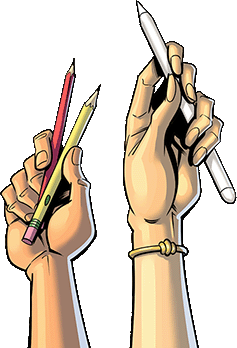How Comic Books Can Change the Way Our Students See Literature
April 1, 2021
Comics have evolved since the first Action Comic #1 broke onto the scene, from basic single strips that appeared daily in the back of the newspaper to complex epics spanning decades and multiple universes and realities.
Regardless if you consider comics and graphic novels literature, you can use them to help your students understand literary themes and techniques quickly and in more depth. Comics also bolster how students feel about reading and learning about literature in general.
Instilling in your students a love of reading, whether it’s books or comic books, is as important as teaching them their A-B-Cs. Here’s how comic books can help change the way your students feel about learning literature.
Comics Mirror Literary Themes
Time magazine awarded a great honor to a humble comic book by including Alan Moore’s Watchmen on its list of the 100 best English-language novels since 1923. Maus won the Pulitzer Prize in 1992, putting it on par with other serious works about the Holocaust like Elie Wiesel’s Night. Even though the former text is created with both images and words, and the latter with only words, they both resonate deeply about the harrowing experiences of Jews in World War II.
These accolades are showered on certain graphic novels because they have the same depth of character and intricacy of plot that many essential novels do. There are two ways you can use comic books to change the way students think about literature – you can use comics to help teach content or use them to teach concepts.
Content
Many famous works of literature, including Hamlet by Shakespeare and Kindred by Octavia Butler, now have graphic novels editions. Each adaptation will be different and put its spin on the plot, but using a graphic novel version of a Shakespearean play in addition to the text may help certain students with plot comprehension.
Concepts
Some literary devices are challenging to understand, and having to identify them in dense texts may be difficult for students to do. Providing a slightly shorter text with easy-to-identify themes could be the gateway to complete comprehension.
If you’re looking for a way to teach your students literature and want to come at it in a couple of ways, graphic novels may be the perfect choice to teach them ideas about literature or the works themselves.
Comics are Multimodal
One tool in a 21st-century teacher’s toolbox is multimodal texts, which express ideas in more than one fashion. Comic books are an ideal representation of a multimodal text, transmitting information visually, spatially, and textually.
Since comics use both visual and written expression, they usually are much shorter than complete works of literature as comic books express transitions or plot twists in a single image instead of pages. This puts many students at ease, as these texts make it easier to navigate challenging concepts due to the visually appealing design.
Comics are cross-curricular, which means they connect ideas spanning all different subjects your students are learning. With visual, engaging images and bright colors, comics quickly draw your students in when a copy of Moby Dick may not.

The Final Word
Using graphic novels and comic books to teach your students elements of literature is a 21st-century approach that leaves them wanting more.
With engaging storylines that use the same literary devices as denser books and bright action-filled panels, your students will learn to love and learn about literature through comics.
For all of your publishing needs, use the professionals at Comix Well Spring. With attentive customer service and years of experience, our printing team will be with you every step of the way.


